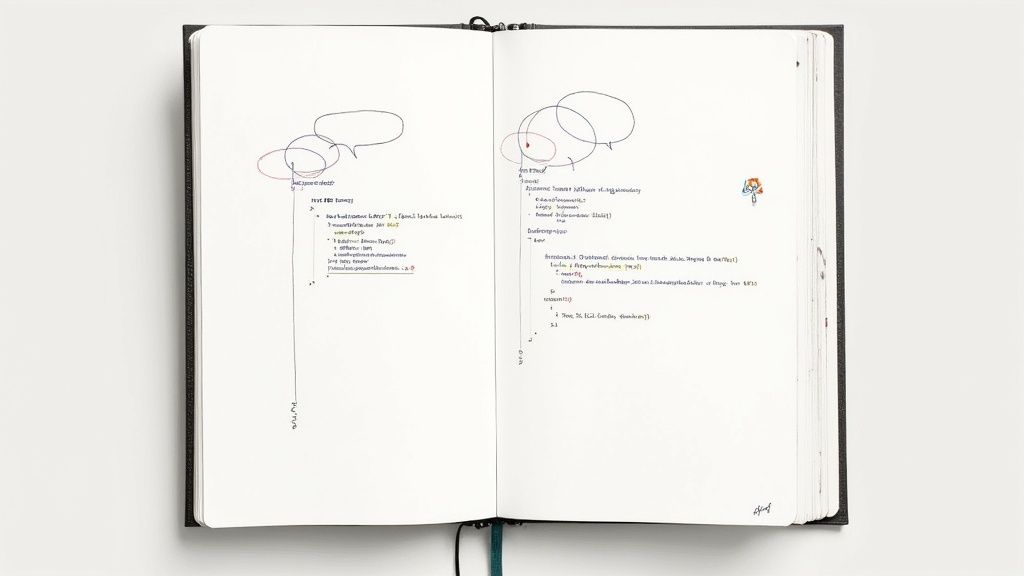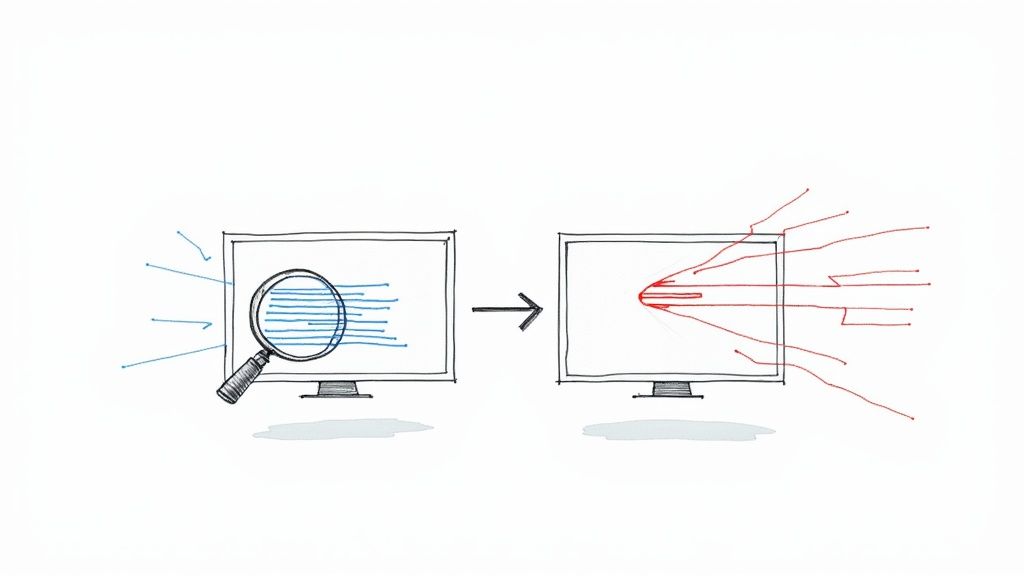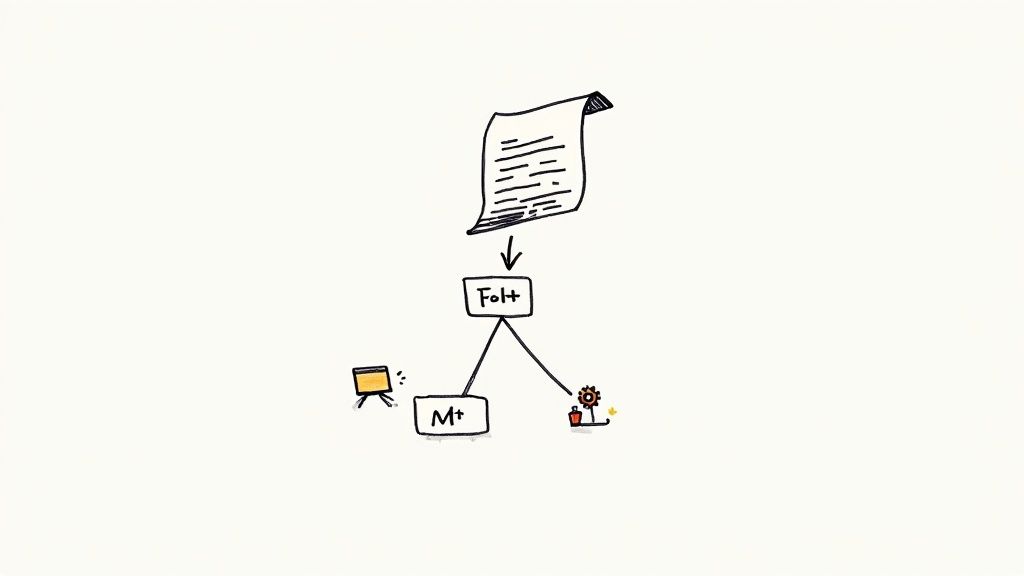Pull Request Checklist: 7 Key Steps for Success in 2025

Level Up Your Code Integration Process
This pull request checklist provides seven essential steps to improve your development workflow and code quality. Learn how to create robust pull requests that minimize bugs, reduce technical debt, and speed up development cycles. From code quality and testing to security and performance, this list covers key areas for a thorough review process. By following these best practices, your team can ensure every change integrated into your codebase meets high standards.
1. Code Quality and Standards Compliance
A crucial first step in any robust pull request checklist is ensuring the submitted code meets established quality and standards guidelines. This involves checking for proper formatting, adherence to naming conventions, consistent code structure, and alignment with language-specific best practices. By prioritizing code quality and standards compliance from the outset, development teams can significantly improve code readability, maintainability, and overall project health. This step ensures that the code being integrated into the main branch is clean, consistent, and adheres to the team's agreed-upon standards. This not only makes the code easier to understand and work with in the future but also prevents the accumulation of technical debt that can slow down development and introduce bugs. It's a fundamental practice for any team aiming to deliver high-quality, sustainable software.

Code quality and standards compliance checks encompass several key features. Automated linting and formatting tools enforce consistent indentation, spacing, and other stylistic elements. The use of meaningful variable and function names, coupled with proper code organization and structure, enhances readability and comprehension. Additionally, removing commented-out code and debug statements keeps the codebase clean and focused. These checks can be easily integrated into the development workflow through pre-commit hooks or CI/CD pipelines, ensuring that code quality is maintained from the very beginning.
Implementing code quality checks brings numerous benefits. Improved code readability makes it easier for developers to understand, modify, and debug the codebase. This directly contributes to enhanced maintainability and reduces the likelihood of introducing bugs during future development. Consistent code also facilitates easier code reviews, as reviewers can focus on the logic and functionality rather than stylistic inconsistencies. This streamlined process promotes better team collaboration and knowledge sharing. Ultimately, adhering to code quality standards reduces technical debt accumulation, allowing for faster development cycles and more efficient use of resources.
While the advantages are numerous, there are also potential drawbacks to consider. Enforcing strict code quality standards can initially slow down development, as developers need to adjust to the rules and spend time formatting and refactoring their code. For legacy codebases, achieving compliance may require extensive refactoring efforts, which can be time-consuming and resource-intensive. Furthermore, coding standards can become outdated over time, requiring periodic review and updates to stay relevant with evolving best practices.
Several successful examples demonstrate the effectiveness of prioritizing code quality. Google’s style guides for various programming languages, Airbnb’s JavaScript style guide, and Microsoft's .NET coding conventions serve as excellent resources and models for establishing consistent code standards. These publicly available style guides provide detailed rules and recommendations for various aspects of code formatting, naming conventions, and best practices, enabling teams to adopt well-established standards and adapt them to their specific needs.
To effectively implement code quality and standards compliance in your pull request checklist, consider the following actionable tips:
- Utilize automated tools: Integrate tools like ESLint, Prettier, or SonarQube into your workflow to automate linting, formatting, and code analysis. These tools can identify potential issues early on, reducing the manual effort required for code reviews and ensuring consistent code quality.
- Establish clear coding standards: Create a comprehensive coding standards document that outlines the specific rules and guidelines your team should follow. This document should be easily accessible to all team members and should be regularly reviewed and updated as needed.
- Implement pre-commit hooks: Configure pre-commit hooks to automatically check for code quality and style violations before code is committed. This prevents developers from introducing non-compliant code into the repository, catching issues early in the development process.
- Foster regular discussions: Encourage regular team discussions about coding standards and their evolution. This allows team members to contribute to the standards, ensuring that they remain relevant and reflect the team's collective best practices.
This emphasis on code quality and standards, popularized by figures like Robert C. Martin (Clean Code principles), Google Engineering Practices, and the Airbnb Engineering Team, is not just a stylistic preference—it’s a crucial investment in long-term project health and maintainability. By integrating these practices into your pull request checklist, you create a foundation for robust, maintainable, and collaborative software development.
2. Comprehensive Testing Coverage
A crucial element of any robust pull request checklist is comprehensive testing coverage. This step verifies that new code not only functions as intended but also doesn't introduce regressions or negatively impact existing functionality. It involves a multi-layered approach, encompassing various testing methodologies to ensure code quality and stability. Before merging any code changes, it's essential to confirm that appropriate tests are included, existing tests continue to pass, and the overall test suite maintains or even improves coverage metrics. This rigorous process minimizes the risk of bugs slipping into production and builds confidence in the reliability of the software.

Comprehensive testing coverage typically includes several key features: unit tests, integration tests, and end-to-end tests. Unit tests focus on the smallest testable parts of an application, isolating individual functions or methods to verify their correct behavior. Integration tests, on the other hand, examine how different components of the system interact with each other, ensuring seamless data flow and functionality across modules. Finally, end-to-end tests simulate real-world user scenarios, testing the entire application flow from start to finish. Other important aspects include regression tests, designed to prevent the recurrence of previously fixed bugs, and performance tests, which evaluate the system's responsiveness and stability under various load conditions. Thorough test coverage reporting provides valuable insights into the effectiveness of the testing strategy and highlights areas needing improvement.
The benefits of incorporating comprehensive testing into your pull request checklist are numerous. First and foremost, it significantly reduces the likelihood of bugs making their way into production, saving time and resources on debugging and patching later. It also enables confident refactoring, as developers can make changes to the codebase knowing that a comprehensive test suite will catch any unintended consequences. Furthermore, the process of writing tests serves as a form of documentation, explicitly defining the expected behavior of the code. This makes the codebase easier to understand and maintain for other developers. Lastly, a solid testing foundation facilitates continuous integration, enabling automated testing and deployment pipelines for faster release cycles.
While the advantages are clear, there are also potential drawbacks to consider. Implementing comprehensive testing inevitably increases development time, as writing and maintaining tests requires effort. There’s also the risk of developing a false sense of security with poor quality tests. If tests are not carefully designed and implemented, they may not effectively catch all potential issues. Finally, maintaining a large test suite can introduce overhead, especially as the codebase grows and evolves.
Several successful companies demonstrate the value of comprehensive testing. Netflix, for example, employs chaos engineering, deliberately injecting failures into their systems to test their resilience and ensure they can withstand real-world disruptions. Spotify uses a testing pyramid approach, prioritizing unit tests at the base, followed by integration tests, and finally a smaller number of end-to-end tests. Amazon rigorously tests its AWS services with automated testing frameworks, ensuring high availability and reliability for millions of users. You can learn more about Comprehensive Testing Coverage including regression test planning.
To effectively incorporate comprehensive testing into your pull request checklist, consider the following tips: Aim for a code coverage of 80-90%, but prioritize the quality of your tests over simply achieving a high percentage. Embrace Test-Driven Development (TDD), writing tests before fixing bugs to define the desired behavior upfront. Choose testing frameworks appropriate for your technology stack and integrate continuous testing into your CI/CD pipeline to automate the process.
Pioneered by figures like Kent Beck (TDD) and Martin Fowler (Testing strategies), and championed by teams like Google's Test Engineering Team, comprehensive testing is a cornerstone of modern software development. By integrating it into your pull request checklist, you can significantly improve the quality, reliability, and maintainability of your codebase. This approach is especially relevant for Software Development Teams, DevOps Engineers, Quality Assurance Engineers, Enterprise IT Leaders, Tech Startups, CI/CD Engineers, and Platforms Engineers looking to build robust and scalable software solutions. By implementing comprehensive testing, your team can deliver high-quality software with confidence, minimize production issues, and accelerate the development lifecycle.
3. Clear and Descriptive Documentation
A crucial yet often overlooked aspect of a thorough pull request checklist is clear and descriptive documentation. This encompasses more than just adding comments to your code; it's about providing comprehensive context and explanation for why changes were made, not just what was changed. Well-maintained documentation dramatically improves knowledge transfer within a team, reduces onboarding time for new members, facilitates future maintenance and debugging, and provides invaluable context for code reviewers. It ensures that the reasoning behind the code's evolution is preserved, preventing the common scenario where code changes outpace the understanding of their purpose.

Effective documentation in a pull request context involves several key components. Inline code comments should elucidate complex logic, explaining the rationale behind specific implementation choices. API documentation must be updated to reflect any changes in functionality or parameters. The README file, serving as the project's front door, should be maintained with accurate and up-to-date information. For significant changes, changelog entries are essential, providing a concise history of modifications. Finally, for larger architectural decisions, Architecture Decision Records (ADRs) provide a formalized record of the reasoning behind key choices, creating a valuable audit trail for future reference.
This multifaceted approach to documentation provides numerous benefits. It fosters a shared understanding of the codebase, making it easier for team members to collaborate effectively. Newcomers can quickly grasp the project's intricacies, accelerating their onboarding process. When debugging issues or adding new features, well-maintained documentation acts as a guiding light, saving valuable time and effort. Furthermore, it provides reviewers with the necessary context to understand the motivation and implications of the changes proposed in the pull request.
Successful implementations of documentation-driven development can be seen in organizations like Stripe, renowned for its comprehensive API documentation, and Atlassian, which champions documentation as an integral part of its development process. Mozilla's MDN web docs also stand as a testament to the power of community-driven documentation. These examples demonstrate that investing in documentation is not just a best practice, but a crucial element of building robust and maintainable software.
However, maintaining comprehensive documentation does have its drawbacks. It requires a significant time investment, which can be challenging under tight deadlines. Documentation can also quickly become outdated if not diligently maintained. Moreover, the importance of documentation can sometimes be overlooked, particularly in fast-paced development environments.
To effectively incorporate documentation into your pull request workflow, consider the following tips:
- Write documentation as you code: Integrating documentation into the coding process prevents it from becoming an afterthought and ensures that it accurately reflects the current state of the code.
- Use documentation generators: Tools like JSDoc, Sphinx, or Swagger can automate parts of the documentation process, making it more efficient and consistent.
- Keep documentation close to the code: Storing documentation alongside the code it describes makes it easier to find and update.
- Regular documentation reviews and updates: Schedule regular reviews to ensure documentation remains accurate and relevant.
This approach is popularized by companies like GitLab, known for their documentation-first approach, and championed by communities like "Write the Docs." By embracing a comprehensive documentation strategy, development teams can significantly improve code quality, collaboration, and long-term maintainability. Including "Clear and Descriptive Documentation" in your pull request checklist ensures that every code change is accompanied by the necessary context and explanation, fostering a culture of knowledge sharing and contributing to a more robust and maintainable codebase. This ultimately benefits not just the immediate development team but also future contributors and the overall success of the project. It becomes an investment in the long-term health and sustainability of your software.
4. Security Vulnerability Assessment
A crucial step in any robust pull request checklist is the Security Vulnerability Assessment. This process scrutinizes code changes for potential security weaknesses before they are merged into the main codebase. It's a proactive measure designed to identify and mitigate vulnerabilities early in the development lifecycle, minimizing the risk of security breaches and ensuring the overall integrity of the software. This assessment involves a combination of automated security scanning tools and manual code reviews performed by security-conscious developers. This multifaceted approach ensures comprehensive coverage and addresses a wider range of potential security flaws.

The scope of a Security Vulnerability Assessment generally encompasses several key areas: authentication issues, authorization flaws, input validation problems, and the potential exposure of sensitive data. For example, it checks if user authentication mechanisms are robust enough to prevent unauthorized access. It also verifies that users have the correct permissions to access specific resources and functionalities (authorization). Input validation is crucial for preventing injection attacks, such as SQL injection and cross-site scripting (XSS). Finally, the assessment ensures sensitive data, like API keys and user credentials, are properly protected and not inadvertently exposed.
Several powerful features contribute to a thorough Security Vulnerability Assessment. Static Application Security Testing (SAST) analyzes the source code without actually executing it, identifying potential vulnerabilities like buffer overflows and cross-site scripting. Dependency vulnerability scanning examines third-party libraries and frameworks used in the project, flagging any known security vulnerabilities in those dependencies. Furthermore, specific checks for input validation and sanitization are essential to prevent injection attacks. Authentication and authorization mechanisms are thoroughly verified to ensure they function as expected. Finally, procedures for protecting secrets and sensitive data are reviewed, such as utilizing secure storage mechanisms and avoiding hardcoding sensitive information.
The benefits of integrating a Security Vulnerability Assessment into your pull request checklist are substantial. First and foremost, it prevents security breaches by catching vulnerabilities before they reach production. It also helps ensure compliance with industry security standards, such as OWASP Top 10 and PCI DSS. By embedding security checks into the development process, you cultivate a security-conscious development culture, empowering developers to think proactively about security. Finally, identifying and fixing vulnerabilities early in the development lifecycle significantly reduces remediation costs compared to addressing them post-release.
While the advantages are undeniable, some potential drawbacks need consideration. The process can slow down the development process, especially initially, as developers adapt to the new procedures. Automated scanning tools can generate false positives, requiring manual review and potentially wasting valuable time. Finally, effective Security Vulnerability Assessment requires specialized security knowledge, which might necessitate training or hiring security experts.
Numerous examples demonstrate the successful implementation of Security Vulnerability Assessments. GitHub's own security features, including security advisories and Dependabot, provide automated vulnerability detection and remediation suggestions within the platform. Many major tech companies meticulously implement the OWASP Top 10, a widely recognized list of web application security risks, as part of their security strategy. Netflix, known for its robust security practices, utilizes tools like Security Monkey for cloud security monitoring and employs extensive automated security testing throughout their development pipeline. You can learn more about Security Vulnerability Assessment and CI/CD security best practices to enhance your understanding and implementation.
To effectively incorporate Security Vulnerability Assessments into your workflow, consider these actionable tips: integrate security scanning tools into your CI/CD pipeline for automated checks; provide regular security training to your development teams to enhance their security awareness; implement the principle of least privilege, granting users only the necessary permissions; and use security-focused code review checklists to guide the manual review process.
Pioneered by organizations like the OWASP Foundation, GitHub Security Team, and Netflix Security Engineering, Security Vulnerability Assessment has become an indispensable part of modern software development practices. Its inclusion in the pull request checklist signifies a commitment to building secure and reliable software, safeguarding both the organization and its users. By proactively addressing security risks early in the development process, you strengthen your application's defenses and establish a foundation for long-term security and success.
5. Performance Impact Analysis
Performance Impact Analysis is a crucial step in the pull request checklist that focuses on evaluating how code changes affect the overall performance of an application. This involves assessing the impact on various performance metrics including execution time, memory usage, database query efficiency, and network call overhead. By incorporating this analysis into your workflow, you proactively identify and address potential performance regressions before they reach production, ensuring a smooth and responsive user experience. This makes it a vital component of any robust pull request checklist.
The core principle of Performance Impact Analysis is to measure and compare the performance of the application before and after the proposed code changes. This comparison helps pinpoint any performance bottlenecks introduced by the new code. The analysis involves both automated performance testing, using benchmarking and profiling tools, and manual review of performance-critical sections of the code. This dual approach helps ensure comprehensive coverage and allows developers to leverage their expertise to identify subtle performance issues that automated tests might miss.
Several key features underpin effective Performance Impact Analysis:
- Execution time benchmarking: Measure the time taken to execute specific code blocks or complete critical user flows. This helps identify functions or operations that might be consuming excessive time.
- Memory usage profiling: Analyze memory allocation and usage patterns to detect memory leaks or areas where memory consumption can be optimized.
- Database query optimization analysis: Examine the efficiency of database queries generated by the code. This includes looking at query execution time, the amount of data transferred, and the number of database calls.
- Network request efficiency review: Evaluate the number, size, and duration of network requests made by the application. Identify opportunities to reduce the amount of data transferred or minimize the number of round trips required.
- Load testing for significant changes: Simulate real-world user traffic to understand how the application performs under stress. This is especially important for changes that could significantly impact the server load.
The benefits of implementing Performance Impact Analysis within your pull request process are numerous:
- Prevents performance regressions: By catching performance issues early in the development cycle, you prevent degradations in application responsiveness and prevent a negative impact on user experience.
- Identifies optimization opportunities: Analysis often reveals areas where code can be optimized for better performance, leading to faster execution and reduced resource consumption.
- Ensures scalability requirements are met: Performance testing helps verify that the application can handle anticipated user loads and scales effectively as demand increases.
- Improves user experience: Ultimately, improved application performance translates to a more responsive and enjoyable user experience.
However, there are also some potential downsides to consider:
- Performance testing can be time-consuming: Setting up and running comprehensive performance tests can add time to the development process, particularly for complex applications.
- May require specialized tools and expertise: Effective performance analysis often requires specialized tools and the expertise to use them effectively.
- Results can vary based on testing environment: Performance test results can be influenced by the testing environment, making it essential to use a representative environment that closely mirrors production conditions.
Several companies have demonstrated the value of focusing on performance. Google's Core Web Vitals initiative emphasizes the importance of key performance metrics for user experience. Facebook uses performance budgets and continuous monitoring to maintain optimal performance. Twitter focuses on real-time performance optimization to deliver a smooth experience to its millions of users. These examples showcase how prioritizing performance can lead to significant improvements in user satisfaction and overall business success.
Here are some actionable tips for incorporating Performance Impact Analysis into your pull request checklist:
- Establish performance budgets and thresholds: Define acceptable limits for key performance metrics. Use these thresholds to trigger alerts or automatically reject pull requests that exceed the defined limits.
- Use profiling tools appropriate for your tech stack: Choose the right profiling and benchmarking tools for your specific technology stack.
- Focus on user-facing performance metrics: Prioritize metrics that directly impact user experience, such as page load times and interaction responsiveness.
- Implement continuous performance monitoring: Integrate performance monitoring into your CI/CD pipeline to track performance trends over time and identify potential regressions early.
By incorporating Performance Impact Analysis as a standard component of your pull request checklist, you elevate the importance of performance in your development workflow. This proactive approach to performance management will result in a more efficient, scalable, and user-friendly application. This ultimately benefits both your users and your business.
6. Meaningful Commit Messages and PR Description
A crucial element of any effective pull request checklist is ensuring meaningful commit messages and a comprehensive PR description. This seemingly small detail plays a significant role in maintaining a healthy and understandable codebase, contributing directly to efficient code reviews, streamlined debugging processes, and a clear project history. In the fast-paced world of software development, where multiple team members contribute to the same project, well-crafted commit messages and PR descriptions are the bedrock of effective collaboration and long-term maintainability. This element of the pull request checklist ensures that every change is documented thoroughly, providing context and clarity for both current and future contributors. By prioritizing this step, teams can avoid confusion, minimize errors, and accelerate development cycles. This is why it holds a prominent place in any robust pull request checklist.
A meaningful commit message should concisely describe what change was made and, more importantly, why it was necessary. It should not merely reiterate the code changes themselves, which are visible in the diff, but should provide the rationale behind the alteration. A comprehensive PR description, on the other hand, expands on this information, providing a broader context of the changes introduced by the pull request. This includes the overall purpose of the changes, the scope of modifications, and the potential impact on other parts of the system. This holistic approach ensures everyone involved understands not just the "how" but also the crucial "why" and "what" of the code changes.
Features of a well-structured commit message and PR description system include adopting a conventional commit message format (like the one popularized by the Angular Team), using clear and concise titles and descriptions, linking related issues and requirements, including notifications for any breaking changes, and even incorporating screenshots or demos for UI changes. For example, following the Conventional Commits specification makes commit messages predictable and easily parsable, benefiting both human readers and automated tools. Clear PR titles and descriptions provide immediate context, enabling reviewers to quickly grasp the intent of the pull request. Linking related issues and requirements helps track progress and understand the context of changes within the larger project scope. Finally, including screenshots or demos provides a visual representation of UI changes, simplifying the review process for front-end modifications.
The advantages of incorporating this practice into your pull request checklist are numerous. Improved project history readability is a key benefit, allowing developers to easily trace back the evolution of the codebase. This also facilitates easier debugging and rollbacks if necessary. Well-written commit messages and PR descriptions drastically enhance code review efficiency by providing reviewers with all the necessary information to understand and assess the changes. From a broader perspective, it leads to better project management and tracking by connecting code changes to specific features, bug fixes, and requirements.
However, there are also some potential drawbacks. Maintaining consistent, high-quality commit messages and PR descriptions requires discipline and can sometimes feel time-consuming, especially for small or seemingly trivial changes. This practice might slow down quick fixes and can become verbose for very simple modifications. Finding the right balance between brevity and completeness is crucial.
Examples of successful implementations of detailed commit message practices can be seen in projects like the Linux kernel, known for its meticulous commit logs, and the Angular project, which championed the Conventional Commits specification. Learn more about Meaningful Commit Messages and PR Description. Linus Torvalds' rigorous approach to commit messages in the Linux kernel has set a standard for open-source development. Similarly, the Angular team’s advocacy for the Conventional Commits specification has made structured and informative commit messages mainstream.
To integrate this effectively into your pull request checklist, consider the following tips: Use a conventional commit format (e.g., feat:, fix:, docs:, etc.), explain the "why" behind the change, not just the "what", reference related issues and tickets, and use PR templates for consistency. PR templates are an excellent tool for ensuring all the necessary information is included in every pull request, streamlining the review process and maintaining quality. By following these guidelines, your team can reap the numerous benefits of clear and comprehensive commit messages and PR descriptions, ultimately leading to a healthier and more maintainable codebase.
7. Backward Compatibility and Breaking Changes
Maintaining backward compatibility is a critical aspect of software development, particularly when dealing with APIs, libraries, or any system with external dependencies. Within the context of a pull request checklist, verifying backward compatibility and managing breaking changes effectively is crucial for ensuring a stable and reliable software ecosystem. This step prevents unexpected disruptions for users and minimizes integration issues when new code is deployed.
Backward compatibility refers to the ability of a new version of a system to work seamlessly with older versions. This means that existing clients or integrations that rely on the older version should continue to function correctly without requiring modifications when the new version is introduced. Breaking changes, conversely, are modifications that render older versions incompatible, necessitating adjustments on the client-side.
How it Works in a Pull Request Checklist:
When reviewing a pull request, developers need to carefully evaluate the potential impact of the changes on backward compatibility. This involves:
- API Version Compatibility Checks: For APIs, this involves ensuring that any modifications do not break existing API contracts. For example, removing an API endpoint, changing the data format of a response, or altering the expected input parameters can all lead to breaking changes. Automated API versioning checks can be integrated into the CI/CD pipeline to flag potential issues during the pull request process.
- Database Migration Scripts: Changes to database schemas need to be managed meticulously. Backward compatibility often requires writing migration scripts that update the database schema in a way that supports both the old and new code. These scripts should be included in the pull request and thoroughly tested.
- Deprecation Warnings and Timelines: If breaking changes are unavoidable, a clear deprecation policy should be implemented. This involves providing advance notice to users about the upcoming change, along with a timeline for the removal of the deprecated feature. This allows users to adapt their code and migrate to the new version without experiencing unexpected disruptions.
- Migration Documentation and Tools: To facilitate a smooth transition for users, providing comprehensive migration documentation and tools is essential. This could include detailed instructions on how to upgrade, examples of code changes, and automated migration scripts.
- Semantic Versioning Compliance: Adhering to semantic versioning (SemVer) principles provides a standardized way to communicate the nature of changes in a release. This allows consumers to easily understand whether a new version introduces breaking changes, new features, or just bug fixes.
Examples of Successful Implementation:
- Stripe's API Versioning: Stripe is known for its robust API versioning strategy, which allows developers to lock their integration to a specific API version and avoid unexpected breaking changes. Stripe provides clear documentation and advance notice for any upcoming deprecations.
- AWS's Approach to Service Evolution: AWS manages backward compatibility across its vast array of services by providing multiple versions of APIs and allowing users to choose which version they want to use. They also offer tools and documentation to assist with migrating to newer versions.
- Google's API Design and Deprecation Policies: Google has established comprehensive API design and deprecation policies that emphasize backward compatibility. These policies provide clear guidelines for developers and ensure a stable experience for API consumers.
Actionable Tips for Pull Request Reviews:
- Follow Semantic Versioning Principles: Use SemVer to accurately reflect the impact of changes in the version number.
- Provide Clear Migration Paths for Breaking Changes: Document the necessary steps users need to take to adapt to any breaking changes.
- Use Feature Flags for Gradual Rollouts: Feature flags allow you to introduce new features or changes gradually, minimizing the risk of widespread disruptions.
- Maintain a Comprehensive API Changelog: Keep a detailed changelog that documents all API changes, including breaking changes, deprecations, and new features.
When and Why to Use This Approach:
Backward compatibility checks should be an integral part of every pull request review, especially for projects that expose APIs, libraries, or have a significant user base. Prioritizing backward compatibility:
- Maintains System Stability: Reduces the risk of unexpected errors and downtime when deploying new code.
- Reduces Integration Issues for Consumers: Prevents breaking changes from disrupting existing integrations.
- Enables Smooth System Evolution: Allows you to introduce new features and improvements without disrupting existing users.
- Builds Trust with API Consumers: Demonstrates a commitment to stability and reliability.
Cons:
While prioritizing backward compatibility is generally beneficial, it also has some potential drawbacks:
- May Limit Innovation and Improvements: Sometimes, breaking changes are necessary to introduce significant improvements or architectural changes.
- Can Lead to Technical Debt Accumulation: Maintaining backward compatibility can sometimes result in complex code and increased technical debt over time.
- Requires Careful Planning and Communication: Managing breaking changes effectively requires careful planning and communication with users.
Despite these potential drawbacks, the benefits of maintaining backward compatibility significantly outweigh the costs, making it an indispensable element of a comprehensive pull request checklist. By following the tips and examples provided, development teams can minimize disruptions, foster user trust, and ensure the long-term stability and success of their software projects.
7-Point Pull Request Checklist Comparison
| Checklist Item | Implementation Complexity 🔄 | Resource Requirements ⚡ | Expected Outcomes 📊 | Ideal Use Cases 💡 | Key Advantages ⭐ |
|---|---|---|---|---|---|
| Code Quality and Standards Compliance | Medium - requires setup of tools and ongoing enforcement | Moderate - automated linters, team training | Consistent, maintainable code | Teams aiming for long-term codebase health and collaboration | Improves readability and reduces technical debt |
| Comprehensive Testing Coverage | High - extensive test writing and maintenance | High - testing frameworks, CI/CD integration | Reduced bugs, confident refactoring | Critical systems needing reliability and continuous integration | Detects regressions early, documents behavior |
| Clear and Descriptive Documentation | Low to Medium - requires consistent effort | Low to Moderate - documentation tools, reviews | Better knowledge transfer and onboarding | Projects with complex logic or large teams | Eases maintenance and aids code reviews |
| Security Vulnerability Assessment | High - specialized knowledge and scanning setup | Moderate to High - security tools and training | Prevented breaches and compliance assurance | Security-critical applications | Protects against vulnerabilities and reduces remediation costs |
| Performance Impact Analysis | Medium to High - requires profiling and analysis | Moderate to High - profiling tools and expertise | Prevented regressions and optimized performance | Performance-sensitive applications | Ensures scalability and improves user experience |
| Meaningful Commit Messages and PR Description | Low - requires discipline and consistent practice | Low - templates and guidelines | Enhanced project history and smoother reviews | Teams emphasizing traceability and clear communication | Improves debugging and project tracking |
| Backward Compatibility and Breaking Changes | Medium to High - planning and coordination | Moderate - versioning tools, migration support | Stable evolutions with minimized integration issues | Public APIs and widely used libraries | Maintains trust and system stability |
Streamlining Your Workflow with Mergify and Your Pull Request Checklist
A robust pull request checklist is the cornerstone of a healthy and efficient software development lifecycle. From ensuring code quality and security to fostering clear communication and minimizing technical debt, the items we've covered – code standards compliance, testing coverage, documentation, security assessments, performance analysis, meaningful commit messages, and backward compatibility checks – are vital for any successful project. Mastering these aspects through a comprehensive pull request checklist significantly improves code review efficiency, reduces the likelihood of bugs in production, and ultimately leads to a higher quality product. This translates directly to cost savings, faster release cycles, and increased customer satisfaction.
The most important takeaway here is the power of consistency. Implementing a well-defined pull request checklist, even a simple one, creates a predictable and reliable development process. This predictability empowers teams to focus on innovation and building exceptional software, rather than firefighting preventable issues. By consistently applying these principles, you cultivate a culture of quality within your engineering organization, setting the stage for long-term success.
By automating your pull request checklist, you can further amplify its benefits. Tools like Mergify seamlessly integrate with your workflow to enforce your checklist items automatically. Mergify's merge queue streamlines the merging process, its merge protections ensure adherence to your defined rules, and its CI insights provide valuable data for continuous improvement. This combination of a well-crafted pull request checklist and intelligent automation empowers your team to scale their development efforts effectively, even in the most demanding environments.
Ready to streamline your code review process and take your team's productivity to the next level? Explore how Mergify can help you automate your pull request checklist and optimize your workflow. Visit Mergify today to learn more and start your free trial.





